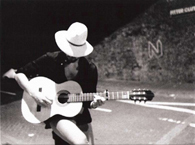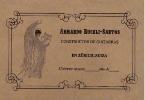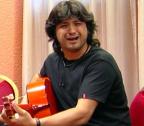Welcome to one of the most active flamenco sites on the Internet. Guests can read most posts but if you want to participate click here to register.
This site is dedicated to the memory of Paco de Lucía, Ron Mitchell, Guy Williams, Linda Elvira, Philip John Lee, Craig Eros, Ben Woods, David Serva and Tom Blackshear who went ahead of us.
We receive 12,200 visitors a month from 200 countries and 1.7 million page impressions a year. To advertise on this site please contact us.
|

|
|
RE: New Guitar problem
|
You are logged in as Guest
|
|
Users viewing this topic: none
|
|
Login  | |
|

   
Ricardo
Posts: 14801
Joined: Dec. 14 2004
From: Washington DC

|
 RE: New Guitar problem (in reply to estebanana) RE: New Guitar problem (in reply to estebanana)
|
|
|
quote:
A string like the nylon treble G tends to play sharp, the reason is that it is a fat string in relation to how flexible it is. When you press it to a fret and stop it, the string does not actually stop at that fret because it's thickness creates a small length of string after the fret that becomes stiffer due to contact with the fret. There is a very, very small length of string that becomes like a little pipe due to contact tension with the fret and to compensate for that after length that tightens up and becomes harder the string length needs to be lengthened. The little stiff pipe section of string shortens the string length.
That is why G strings on Nylon string guitars often have longer compensation that the other strings. You can sometimes see wide saddles with a notch letting the G string ride farther back towards the tie block. All the strings do that physical hardening where they contact being stopped, and at the nut also, but the G string is biggest in diameter and sometimes requires a bit more compensation due to it's tendency to create a stiffer after length at the stop point.
I was assuming this description was the reason. I totally get the theory behind it. Now, based on the "little pipe" concept, if you guys could imagine a nylon string guitar with a SCALLOPED fingerboard. That idea is an exaggeration but to make my point that luthier's should not really be assuming that a stopped string will go all the way down to the fingerboard....thus the "little pipe" curvature (therefore the pitch) will be extremely variable by fret height, string type and by finger pressure. Further, when the string is "Stopped" is not stopped perfectly DOWN toward the fingerboard, it may be slightly pushed toward the bridge, or slightly pulled toward the nut. Unless you are the terminator and can apply a perfect downward pressure. IN my novice brain, a "compensated-for-the-little-pipe-deal" saddle, will work great for a nut puller (who tends to push and pull sharp anyway....they are out there trust me), and be way too flat (over compensated) for a bridge pusher. Hence, my feeling it's arbitrary except for a specific players style that might need it baddly.
I concede it might be more of an issue than I am thinking if I could just compare some guitars I know have it or don't. I for one admit I never had a problem with normal fat G strings so many complain about...my fingers simply got used to the difference I guess? Goes for the weird bridges and the coffee colored string etc... jump out at me as "G string phobia" or something. 
_____________________________
CD's and transcriptions available here:
www.ricardomarlow.com
|
|
|
|
REPORT THIS POST AS INAPPROPRIATE |
Date Feb. 25 2014 4:35:19
 |
|

   
Ricardo
Posts: 14801
Joined: Dec. 14 2004
From: Washington DC

|
 RE: New Guitar problem (in reply to Anders Eliasson) RE: New Guitar problem (in reply to Anders Eliasson)
|
|
|
1) because I played almost all the makes on the list so my fingers memory has some reference. Particular good comparison is the slight adjustment of Ramirez 1A vs Hauser....something I can feel the difference of and had certainly noticed many years ago.
2.) "Without going into a whole dissertation, in general, the Hauser family puts too much compensation on their bridge placement, usually about 3mm longer from 12 to saddle than from nut to 12th. So for most players, they play a bit flat as you ascend the fingerboard. Modern Ramirez 1a's have the saddle slightly slanted, with the first string side placed so the 12th fret is the exact 1/2 distance, and the basses slightly longer (12th to saddle), maybe about 1mm compensation max, which is not enough for most players. Previous generations of Jose Ramirez, like most Spaniards, place the bridge so the 12th is the exact 1/2 distance, although you will often find they miss sometimes due to sloppy, careless measuring. My '67 Faustino Conde media luna is intonated with the 12th fret exactly in the mid point (no compensation), ditto my '34 Santos, ditto my '55 Barbero, ditto my '62 Arcangel and ditto my '98 Gerundino. In general, this is the way Spanish makers placed their bridges in the days of gut strings and LOW actions, and it works in that situation. When you use slippery nylon, and raise the action to the height acceptable to most modern classical (or many modern flamenco players) then you need to place the bridge about 1-1.5mm further back from the 12th fret than the distance from the nut to the center of the 12th fret to allow for the slight sharpening of the string when you press it to the fret. Its that simple."
-Richard Brune
_____________________________
CD's and transcriptions available here:
www.ricardomarlow.com
|
|
|
|
REPORT THIS POST AS INAPPROPRIATE |
Date Feb. 27 2014 15:43:40
 |
|

  
Anders Eliasson
Posts: 5780
Joined: Oct. 18 2006

|
 RE: New Guitar problem (in reply to Ricardo) RE: New Guitar problem (in reply to Ricardo)
|
|
|
quote:
quote:
I experienced the same when making the same design but going from gluing the braces on a scooped out solera to gluing on a flat surface.
What made you switch to flat tops?
I've been doing this for awhile and find that flat tops seem to work better for me.
Actually, I build the top flat but then put a slight curve in the bridge to pull the top into it when it is glued to the top's surface.
After the top is tapered around the sides a little behind the bridge, giving it a slight curve across, then the bridge finishes out the curve behind the bridge and leaves the top in front of the bridge completely flat.
How do you like the difference with a flat top?
I switched to flat top some 4 years ago because after trying, I prefered the sound, the pulsation and the strings over the soundboard which becomes more parallel. The guitars are more lively and with a more open sound.
When I say that I glue the braces on a flat surface, it doesnt mean the the soundboard ends up being flat. It ends up at some 1,5mm - 2mm higher at the bridge than at the sides and so it has enough "space" to move when humidity changes. I dont use a bridge plate, but a bridge strap just like Barbero did on many of his guitars and what Reyes does to a smaller degree. I make it very thin and light 1mm thick and 10 mm wide and I taper it down to 0 at the sides. This bridge strap makes the soundboard lift a little bit (at least in my hands) Just what I need. I hollow the inside of the of the bridge to fit the shape of the soundboard. Its all done with the idea of assembling with as little stress as possible. Nothing is forced into its shape. The drag of the strings slightly lifts the top behind the bridge and slightly flattens it in front (not dishing only flattening)
The flamenco guitar with its low bridge setup is a stringed instrument with little power built into the bridge, so it needs to vibrate as free as possible in order to do its job.
Many guitars built by bracing in a hollow solera ends up with to much curve in the soundboard. I consider 3mm or more to be to much. The sound gets "nosy" and the sondboard tend to dish more easily in front of the bridge and also with more dome in the top, it gets more difficult to control the height of the strings at the bridge and at the soudhole. Often you get to much angle and a stringheight at the soundhole which is to high.
But hey everyone, this is just me, my taste and my way of building. there are 1000 ways of getting to Rome and noone says you have to go to Rome at all. 
_____________________________
Blog: http://news-from-the-workshop.blogspot.com/
|
|
|
|
REPORT THIS POST AS INAPPROPRIATE |
Date Feb. 28 2014 8:00:00
 |
|
 New Messages New Messages |
 No New Messages No New Messages |
 Hot Topic w/ New Messages Hot Topic w/ New Messages |
 Hot Topic w/o New Messages Hot Topic w/o New Messages |
 Locked w/ New Messages Locked w/ New Messages |
 Locked w/o New Messages Locked w/o New Messages |
|
 Post New Thread
Post New Thread
 Reply to Message
Reply to Message
 Post New Poll
Post New Poll
 Submit Vote
Submit Vote
 Delete My Own Post
Delete My Own Post
 Delete My Own Thread
Delete My Own Thread
 Rate Posts
Rate Posts
|
|
|
Forum Software powered by ASP Playground Advanced Edition 2.0.5
Copyright © 2000 - 2003 ASPPlayground.NET |
0.09375 secs.
|


 Printable Version
Printable Version












 New Messages
New Messages No New Messages
No New Messages Hot Topic w/ New Messages
Hot Topic w/ New Messages Hot Topic w/o New Messages
Hot Topic w/o New Messages Locked w/ New Messages
Locked w/ New Messages Locked w/o New Messages
Locked w/o New Messages Post New Thread
Post New Thread